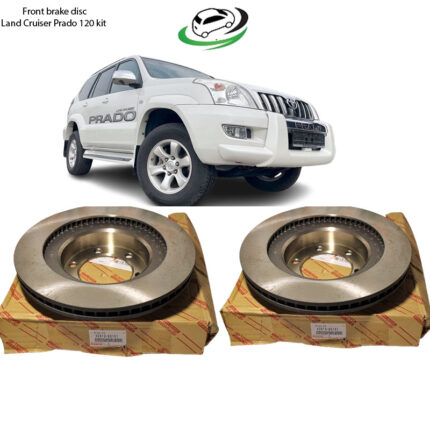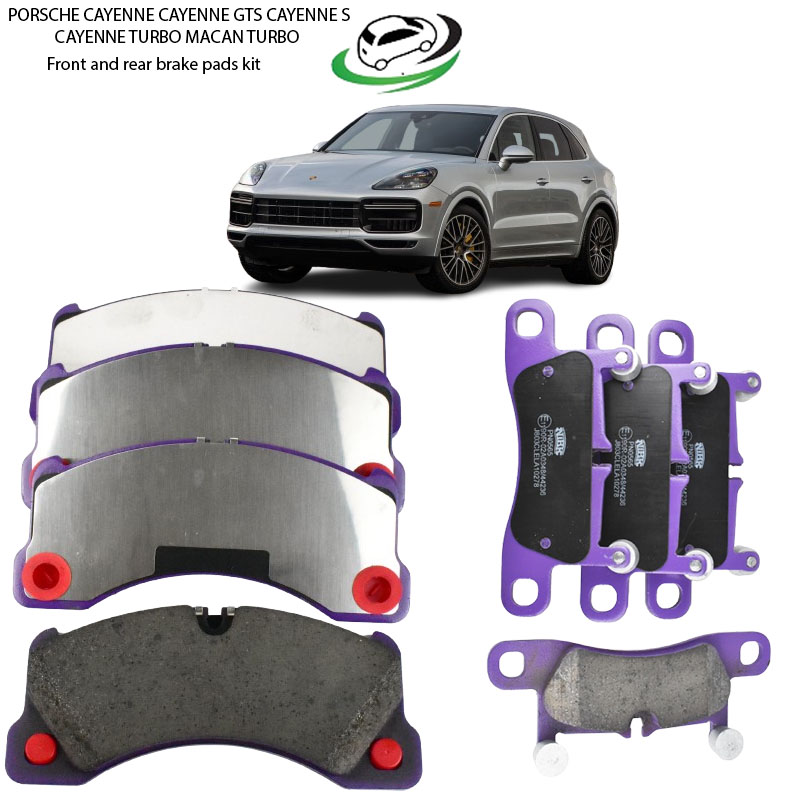Get Porsche Cayenne Front & Rear Brake Pad Kit PN0529 / PN0530
A front and rear brake pad kit is an essential part of a vehicle’s braking system, containing both front and rear brake pads designed to work in tandem for optimal stopping power. These kits are crucial for ensuring even braking distribution, maximizing performance, and enhancing safety. In this comprehensive guide, we will explore the function of front and rear brake pads, the benefits of using a complete kit, and key maintenance tips to keep your braking system in top shape.
Functions of Front and Rear Brake Pads
Brake pads play a pivotal role in slowing down or stopping your vehicle by creating friction when pressed against the brake rotors (discs). Both the front and rear brake pads are vital for maintaining balance and stability during braking. Let’s dive deeper into how they function:
- Front Brake Pads:
- Front brake pads handle the majority of the braking load due to the forward shift of weight when a vehicle slows down. Typically, front brakes are larger and more robust as they need to generate more friction to stop the car.
- They engage when the brake pedal is pressed, causing the calipers to squeeze the brake rotors. The friction between the brake pads and rotors converts kinetic energy into thermal energy, decelerating the vehicle.
- Rear Brake Pads:
- Rear brake pads provide stability and balance by assisting in the overall braking process. Although they handle less of the load compared to the front pads, they are essential for preventing the rear of the vehicle from sliding or losing control during braking.
- Rear brakes are particularly important during emergency stops or while driving in slippery conditions. They also play a significant role in vehicle handling and are often equipped with parking brake functionality.
Why Choose a Complete Brake Pad Kit?
A front and rear brake pad kit offers several advantages over purchasing individual brake pads. Here are the key benefits of investing in a complete kit:
1. Balanced Braking Performance
A brake pad kit ensures that both the front and rear pads are of the same quality and specification, designed to work together harmoniously. This balance is crucial for maintaining even brake distribution and ensuring consistent stopping power across all four wheels.
- Front-heavy braking (with strong front pads but weak rear pads) can lead to excessive wear on the front components and may cause handling issues.
- Overreliance on rear brakes can cause the rear wheels to lock up, leading to skidding or instability. A balanced set ensures that braking force is distributed evenly across both axles.
2. Cost-effectiveness
Purchasing a front and rear brake pad kit can be more cost-effective than buying the pads separately. Most kits are priced at a discount compared to individual components, saving you money while ensuring quality.
3. Ease of Installation
When replacing brake pads, it’s convenient to have both front and rear pads in a single package. Mechanics and DIY enthusiasts appreciate the simplicity of having all necessary components in one kit, reducing the chances of compatibility issues or part mismatches.
4. Optimized Material Composition
Front and rear brake pad kits are manufactured using materials optimized for their respective locations. Since front brakes handle more heat and stress, the pads are often made from materials like semi-metallic compounds, while rear brake pads may consist of softer materials like organic or ceramic compounds. These material differences ensure the right balance between performance and durability.
5. Improved Safety
Using a complete brake pad kit improves overall safety by ensuring that your vehicle has matching, high-quality brake components. Kits are engineered and tested to meet or exceed safety standards, reducing the risk of brake failure.
6. Longer Lifespan
Genuine brake pad kits are made from premium materials and are designed to offer a longer lifespan compared to cheaper, generic alternatives. Their durability minimizes wear and tear, allowing for extended intervals between replacements.
Materials Used in Brake Pads
Brake pads are made from different materials, and each type has its pros and cons. The material you choose should depend on your driving style, environment, and vehicle type. The most common types of brake pad materials include:
- Semi-Metallic Brake Pads:
- Composition: A mix of metal fibers (such as steel) and organic compounds.
- Benefits: Excellent heat dissipation and durability, making them ideal for high-performance vehicles and heavy braking situations.
- Drawbacks: They can be noisier and wear down the rotors more quickly than other materials.
- Organic (Non-Asbestos Organic) Brake Pads:
- Composition: Made from a mixture of natural materials such as rubber, carbon, and glass.
- Benefits: Quieter operation, less wear on brake rotors, and more environmentally friendly.
- Drawbacks: They tend to wear out faster and generate more dust than other types.
- Ceramic Brake Pads:
- Composition: Ceramic fibers and non-ferrous materials.
- Benefits: Superior stopping power, low noise, and minimal dust production. Ceramic pads also have excellent longevity and are less abrasive on rotors.
- Drawbacks: Higher cost and less effective in extremely cold climates.
Signs That You Need to Replace Brake Pads
Knowing when to replace your front and rear brake pads is crucial for maintaining a safe and efficient braking system. Here are common signs of worn brake pads:
- Squealing or Squeaking Sounds: High-pitched noises while braking indicate that the pads’ wear indicators are making contact with the rotors, signaling that it’s time for replacement.
- Grinding Noise: A grinding or growling sound means that the brake pads are completely worn down, and the metal backing plate is now rubbing against the rotor, potentially causing damage.
- Longer Stopping Distance: If you notice that it takes longer to stop the vehicle, it could be a sign of worn brake pads, reducing their ability to create the necessary friction.
- Brake Pedal Vibrations: A vibrating brake pedal can indicate warped rotors or uneven wear on the brake pads, which can affect braking performance.
- Thin Brake Pads: If the thickness of the brake pads is less than 1/4 inch, they need to be replaced. You can check this visually through the spokes of the wheel.
Maintenance Tips for Front and Rear Brake Pads
To maximize the lifespan and performance of your brake pads, follow these maintenance tips:
1. Regular Inspections
Inspect brake pads every 12,000 to 15,000 miles or at each oil change. Pay close attention to the pad thickness, rotor condition, and any signs of abnormal wear or damage.
2. Timely Replacements
Avoid waiting until the brake pads are completely worn down to replace them. Replacing them early prevents damage to the rotors and calipers, which could lead to more costly repairs.
3. Brake Fluid Maintenance
Ensure that the brake fluid is topped up and clean. Contaminated or low brake fluid can affect the braking system’s efficiency and lead to premature wear of the pads.
4. Even Wear Monitoring
Keep an eye on how evenly the brake pads are wearing. Uneven wear could indicate issues with the calipers or other braking components, and prompt action should be taken to avoid further damage.
5. Rotor Resurfacing
When installing new brake pads, check the rotors for wear or scoring. Resurfacing the rotors ensures that the pads make even contact, prolonging their lifespan and improving braking performance.
6. Brake Caliper Maintenance
Sticking or malfunctioning brake calipers can cause uneven pad wear or overheating. Regularly inspect and clean calipers to ensure they are functioning properly.
7. Driving Habits
Braking aggressively or riding the brakes can wear down the pads faster. Aim to brake gradually and allow for more stopping distance to prolong pad life.
Conclusion
A front and rear brake pad kit is an indispensable part of a vehicle’s braking system, offering a well-rounded solution for balanced and safe braking. The use of a complete brake pad kit ensures even distribution of braking force, enhances performance, and extends the lifespan of both the pads and rotors. With regular inspections, proper maintenance, and timely replacements, you can enjoy the full benefits of your brake pad kit and ensure a safer driving experience for you and your passengers.
Follow us on Facebook for more parts.





Reviews
Clear filtersThere are no reviews yet.